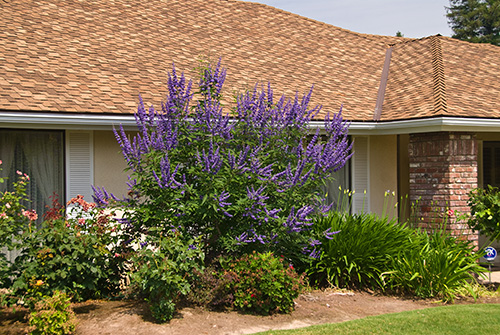
When I was asked to consider growing Vitex not all that many years ago, I confess I had to look it up. As I read various descriptions, the feature that jumped out at me was the very wide range of climates that this large shrub/small tree grew well in. I remember reading that it had a range from Washington State to the Desert Southwest with even more prolific blooming in the hotter climates. As a nursery grower that ships to nearly every climate in North America, that sounded intriguing, maybe even promising. Vitex is hardy in U.S.D.A. Zones 6-10.
Time has now passed and we have become very familiar with Vitex agnus-castus (often just called Vitex). In past years I was impressed with some large shrubs in the neighborhood that I mistakenly thought were Butterfly Bush (Buddleia) and its prolific, early summer blooms. Now I recognize them as they truly are, Vitex agnus-castus. Taking a look at the blooms can illustrate the confusion.
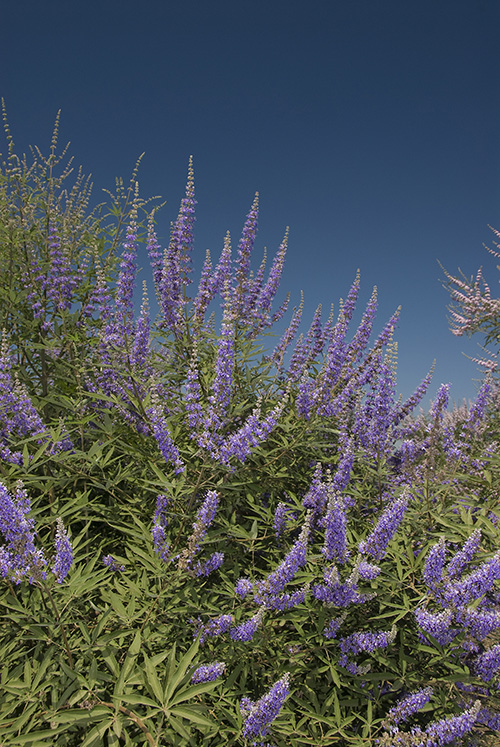
As you can see, Vitex is noteworthy for its showy, summer display (late springtime in the deep South) of fragrant, upwardly pointing, terminal panicles of lavender blooms. These blooms are quite attractive to butterflies, bees and Humming Birds. The tree is sometimes planted where honey is marketed to promote excellent honey production.
Starting in early summer, flowers begin opening from the bottom of the flower stem and continue up the stem over the course of four or five weeks until the bush is completely blanketed in eye-popping bloom. Harvesting these flowers early in the bloom cycle is the best way to preserve them for craft use. They may be used fresh or hung upside down in small bunches for drying. Many aromatic black or brown seeds may be set, but if the spent spikes are cut off promptly after the first flowering the shrub will bloom again.
What About Colors?
Most Vitex is grown from seed and usually provides a lavender - purple - blue bloom. We started our experience with Vitex from seed and still offer seed grown Vitex in bush and tree forms. We also discovered the seedlings which usually provided lavender blooms can also produce a wide variance in colors - something not always appreciated if your bloom does not meet expectations.
Over time we have collected the best colors and now have an outstanding White selection and an outstanding Pink selection grown by clonal reproduction.
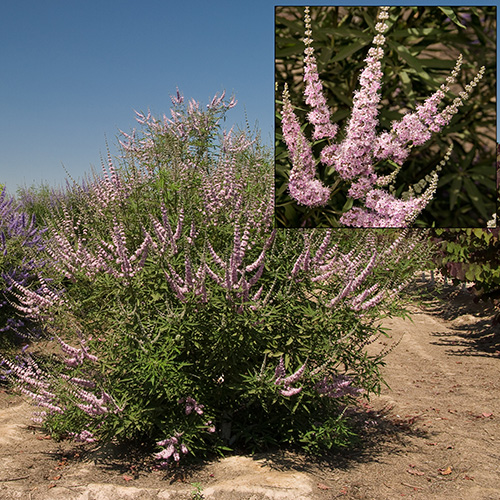 Cooke's Selection Pink Vitex
Cooke's Selection Pink Vitex
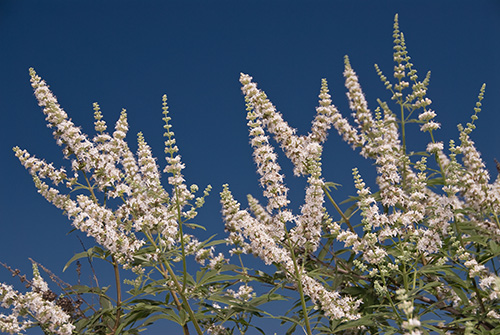
Cooke's Selection White Vitex
These Pink and White selections are truly unique, very attractive and growing in popularity as they are more widely seen. They stand out in our scion wood orchards.
Although Vitex normally blooms as lavender-blue, we are trying to guarantee the best colors. So clonal production of excellent Purple and Blue selections are being offered too. We are still selecting the best single parent plant for each color as we have 3 to 4 plants of each that have risen to the top to choose between. I am finding this a bit more difficult as an excellent Purple today looks bluer when it fades in the following weeks. None-the-less, a "Select" Blue or "Select" Purple from our catalog will not disappoint by coming out some unknown shade of color as can happen with the seed grown product.
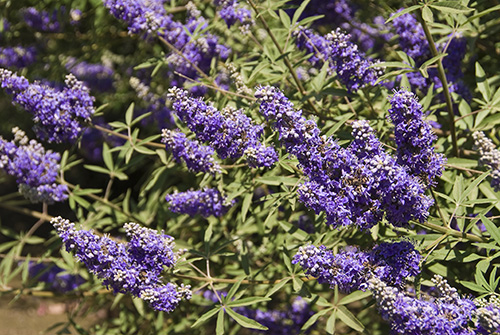
Still trying to select the best Blue and the best Purple
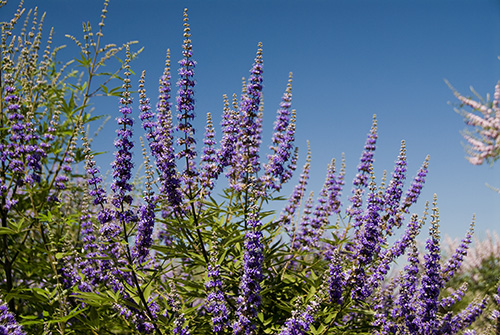
Where Did The Various Names Come From?
The common name "Chaste Tree" has its roots in antiquity. The species name Agnus castus originates from the Greek agnos castus, meaning chaste, as the Greeks thought the plant calmed sexual passion. Athenian women used the leaves in their beds to keep themselves chaste during the feasts of Ceres.
As the flowers of summer fade, small dark purple berries follow. In the past these berries have been dried and used as a rather weak substitute for pepper and as an ingredient in Mediterranean spice mixtures. In the 6th century, the ground dried berries were touted as a must for monks trying to maintain their vows of chastity - thus, the common name Monk's Pepper.
The aromatic, sage scented, leaves are palmate, with five to seven leaflets. At first glance it is often mistaken for Hemp/Marijuana thus it is sometimes called Hemp Tree. Those trying to smoke the leaves have been disappointed.
For over 2500 years Vitex has been considered a vital herb for its various medicinal properties - which is beyond the scope of this article. If you want to explore other uses beyond beautifying landscapes, just Google search on Vitex and see all the possible other proven and some unproven benefits.
Growing Vitex
Vitex grows naturally as a large, multi-stem shrub from 10 to 15 feet tall and 10 to 20 feet wide. It can also be trained into a tree which will also reach 10 to 15 feet tall and about as wide. We grow it both ways - tree and shrub forms in all four color choices.
Vitex should be grown in full sun or partial shade.
We have found Vitex to be a very accommodating and tough plant. It is native to woodlands and dry areas of southern Europe and western Asia. It is easy to grow in almost any soil that has good drainage. Even tolerant of salt drift. Vitex is very drought tolerant once established but can handle lots of water if well drained. The chaste tree can nearly take care of itself, but can be pushed to faster growth with light applications of fertilizer in spring and early summer and by mulching around the plant.
If pruning is desired to control the size and shape, it should be done in winter, since blooms form on new wood.
As with most plants and trees, there are appropriate locations for this tree and others not recommended. Since this plant sets seed, it can self propagate in the right environments. Although I have not found it on any official lists, in some climate areas it is being discussed for invasive species status.
No pests are of major concern. It can get root rot in poorly drained soil. Leaf spot can be a problem in some climates. Surface roots are usually not a problem.
Usage
Because of its many admirable attributes, Vitex is a garden favorite wherever in the world it can be grown. The showy Chaste Tree makes a particularly effective specimen - use it as the centerpiece of a lawn or in large containers. Plant near patio or deck where it can be seen but not too close though as it can attract crowds of hungry bumble bees.
It makes a colorful addition to a mixed border if kept pruned to shrub size. In bush form, Vitex probably looks best unpruned. Leave it to sprawl and it will eventually form a large green sphere of foliage and flower. It is recommended for buffer strips around parking lots or for median strip plantings in the highway.
Beautiful and tough. Vitex agnus-castus has features to meet your landscape needs.
More information can be found on L.E. Cooke Co and more photos on www.CreatorsPalette.com

